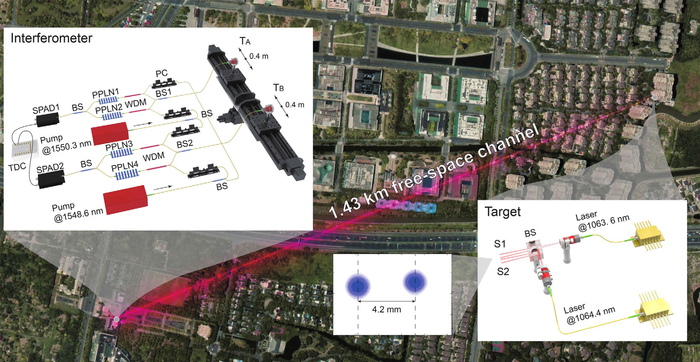Reviewed by Alex SmithSep 20 2021
Interferometers find extensive use in several high-spatial-resolution imaging methods to achieve a higher diffraction limit. Yet, the traditional interferometric technique work only when the photons are of the same wavelength.
 Scheme of the chromatic intensity interferometer. Image Credit: Lu-Chuan Liu et al.
Scheme of the chromatic intensity interferometer. Image Credit: Lu-Chuan Liu et al.
A group of scientists from the University of Science and Technology of China (USTC) of the Chinese Academy of Sciences developed a chromatic intensity interferometer based on a periodically poled lithium niobate waveguide (PPLN) and successfully quantified two very close laser sources of distinct wavelengths. The study has been published in Physical Review Letters.
Frank Wilczek, a Nobel Prize winner, and his collaborators theoretically proposed, in 2016, that photons of varying wavelengths could penetrate the detector to interfere and extract the phase information by introducing a color erasure detector, which works based on frequency conversion into an intensity interferometer. This new method was then called chromatic intensity interferometry.
Then, Prof. Jianwei Pan’s team developed single-photon detectors with the PPLN waveguide built by Jinan Institute of Quantum Technology. Using that, they showcased the intensity interference technique in the laboratory (Phys. Rev. Lett. 123, 243601 (2019); Opt. Express 28, 32294 (2020)).
Researchers verified the high spatial resolution imaging of the chromatic intensity interferometry by performing a series of field experiments. They used two pump lasers of varying wavelengths (1063.6 and 1064.4 nm, respectively) to pump a couple of parallel PPLN waveguides and realized that color erasure detectors could not differentiate between photons of 1063.6 and 1064.4 nm.
Using both the detectors, they installed two telescopes to create an intensity interferometer with a baseline length of 80 cm. They measured the distance between two laser sources isolated by 4.2 mm at a distance of 1.43 km by telescopes and put forward a phase fitting technique to derive the angular distance between both the laser sources.
Fascinatingly, the outcomes exceeded the diffraction limit of a single telescope by nearly 40 times, which demonstrated that the chromatic intensity interferometry exhibited a higher spatial resolution.
Using the multi-wavelength setting, this approach increased the application of intensity interferometry to various fields like space remote sensing, space debris detection, and astronomical observation.
Journal Reference:
Liu, L.-C., et al. (2021) Improved Spatial Resolution Achieved by Chromatic Intensity Interferometry. Physical Review Letters. doi.org/10.1103/PhysRevLett.127.103601.